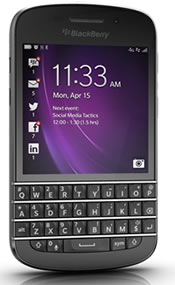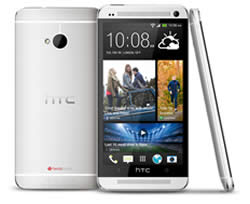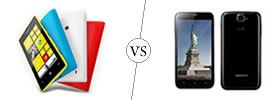Difference between Blackberry Q10 and HTC One
Key Difference: The BlackBerry Q10 has a 3.1-inch AMOLED capacitive touchscreen that allows users to access data using touch and weighs approx 139 grams. Below the screen, there is a full QWERTY keyboard that is similar to those found on the old BlackBerrys. The device is powered by 1.5 GHz Cortex-A9 Dual-core TI OMAP 4470 processor and PowerVR SGX544 GPU. HTC has launched its flagship phone HTC One with a brand new Qualcomm quad-core processor which sports a 4.7 inch Super LCD3 screen, with Full HD1080p, 468 PPI and corning gorilla glass 2.
 Blackberry added a new phone, Q10, to its growing line-up that is aimed at the original users as it features a full QWERTY keyboard. Separating themselves from the full-touch smartphones, the company is trying to garner attention among the users that do not have time to play with touchscreen and require keyboard for typing. However, fret not; the device is also has touch capability on its screen.
Blackberry added a new phone, Q10, to its growing line-up that is aimed at the original users as it features a full QWERTY keyboard. Separating themselves from the full-touch smartphones, the company is trying to garner attention among the users that do not have time to play with touchscreen and require keyboard for typing. However, fret not; the device is also has touch capability on its screen.
The BlackBerry Q10 has a 3.1-inch AMOLED capacitive touchscreen that allows users to access data using touch and weighs approx 139 grams. Below the screen, there is a full QWERTY keyboard that is similar to those found on the old BlackBerrys. The phone has a custom glass-weave black panel that can be popped off to access the battery, SIM and microSD card slots. The USB and the charging port can be found on the left side of the device, while the right side has the volume rocker and a middle button for play/pause and quickly toggling vibration mode. The Power button is placed at the top of the screen, while the mic and the loudspeaker are placed on the bottom of the device. The back of the device has the camera and the flash, which is separated from the removable back by a metal band.
The device is powered by 1.5 GHz Cortex-A9 Dual-core TI OMAP 4470 processor and PowerVR SGX544 GPU. The device comes with 2 GB RAM, 16 GB of internal storage system that can be expanded by 64 GB via SD card. The device comes with an 8MP primary camera and a 2MP secondary camera. The primary camera comes with multiple features such as 5-element F2.2 lens, Dedicated ISP (image signal processor) with 64MB frame buffer, Enhanced Super Resolution Digital Zoom (5x), 4 DOF (Degrees of freedom) video stabilization, Hybrid absorptive IR filter and Time Shift.
The company has also incorporated the features and apps that are found in the Z10 including The Hub, which is a screen that is available by swiping left after the first menu page and task switcher and it is creates a single point where the user can check all updates from SMS, e-mail to facebook notifications. The phone also comes with Blackberry Balance that allows users to create multiple profiles on their phone separating their professional life from their personal life. Other included features also include LED Indicator, BlackBerry Story Maker, Universal Search, already loaded Blackberry Apps and other apps such as Facebook, Twitter, LinkedIn, etc. The phone houses a 2100 mAH removable battery.
 HTC One was originally launched as the brand name for a series of Android phones by the company. These included HTC One X, HTC One X+, HTC One V, etc. Now, the company launched a new phone with the name HTC One. The HTC One X was launched in May 2012. This often causes confusion as this phone is expected to be a successor to the One X. HTC One is expected to be superior compared to the One X in hardware design and software design. It also includes a unique camera implementation.
HTC One was originally launched as the brand name for a series of Android phones by the company. These included HTC One X, HTC One X+, HTC One V, etc. Now, the company launched a new phone with the name HTC One. The HTC One X was launched in May 2012. This often causes confusion as this phone is expected to be a successor to the One X. HTC One is expected to be superior compared to the One X in hardware design and software design. It also includes a unique camera implementation.
In terms of hardware and software, HTC One sports a 4.7 inch Super LCD3, with Full HD1080p, 468 PPI and corning gorilla glass 2. The HTC One comes with Android v4.1.2 Jelly Bean that is upgradable to v4.2.2. The case is an all-aluminum frame with an antenna built into its backing. It includes a 1.7 GHz quad-core Snapdragon 600 processor, Adreno 320 GPU and 2 GB DDR2. The phone is available with non-expandable, 32 or 64GB internal capacity. It offers a 4 megapixel 2688 x 1520 pixels primary camera with autofocus, LED flash and BSI sensor, along with a 2.1 MP, 1080p@30fps, HDR secondary camera.
The main feature is the new pixilation system that is opted in the primary camera of the phone, which provides each pixel size of 2.0 µm and sensor size of 1/3'. The One also includes a new camera app known as ‘Zoe’, which records a short video alongside every photo taken and allows the resulting photos and videos to be automatically combined and synchronized with music to produce a multimedia presentation known as a Zoe. The One also offers a new feature on the home screen known as the BlinkFeed. This is a newsfeed that automatically upgrades every two hours if connected with a mobile service or more frequently when connected via WiFi. The BlinkFeed takes up the main home screen and cannot be removed, resulting in the home screen as not being as customizable as in the previous phones. The price of the phone has not yet been released.
The information for the detailed table about the two phones has been taken from the Blackberry website, HTC website and GSMArena.com.
|
|
Blackberry Q10 |
HTC One |
|
Launch Date |
April 2013 |
Expected release March 2013 |
|
Company |
Research In Motion |
HTC Corporation |
|
Size |
119.6 x 66.8 x 10.4 mm |
137.4 x 68.2 x 9.3mm |
|
Display |
3.1-inch Super AMOLED capacitive touchscreen |
4.7 inch Super LCD3 |
|
Screen |
720 x 720 pixels (~328 ppi pixel density), 16M colors |
1080p, 468 PPI (Full HD) |
|
Protection |
- |
Corning Gorilla Glass 2 |
|
Weight |
139 grams |
143g |
|
2G Network |
GSM 850 / 900 / 1800 / 1900 - all versions CDMA 800 / 1900 - SQN100-2, SQN100-4 |
HSPA/WCDMA: Europe/Asia: 850/900/1900/2100 MHz |
|
3G Network |
HSDPA 850 / 1900 / 2100 - SQN100-1 HSDPA 850 / 900 / 1900 / 2100 - SQN100-2, SQN100-3, SQN100-4 HSDPA 850 / 1700 / 1900 / 2100 - SQN100-5 |
GSM/GPRS/EDGE: 850/900/1800/1900 MHz |
|
4G Network |
LTE 700 / 850 / 1700 / 1900 - SQN100-1, SQN100-5 LTE 700 / 1700 - SQN100-2 LTE 800 / 900 / 1800 / 2600 - SQN100-3 LTE 1900 - SQN100-4 |
Depends on market availability. |
|
GUI |
BlackBerry Flow user interface |
HTC Sense 5 |
|
CPU speed |
1.5 GHz Cortex-A9 Dual-core |
Qualcomm® Snapdragon™ 600, quad-core, 1.7GHz |
|
GPU |
PowerVR SGX544 |
Adreno 320 |
|
OS |
BlackBerry 10 OS |
Android OS, v4.1.2 (Jelly Bean), upgradable to v4.2.2 (Jelly Bean) |
|
Chipset |
TI OMAP 4470 |
Qualcomm APQ8064T Snapdragon 600 |
|
RAM |
2GB |
2 GB DDR2 |
|
SIM Size |
mircoSIM |
microSIM |
|
Internal Memory |
16 GB |
32/64 GB |
|
Expandable Memory |
Up to 64 GB |
No |
|
Sensors |
Accelerometer, Magnetometer, Proximity sensor, Gyroscope, Ambient light sensor |
Gyro sensor, Accelerometer, Proximity sensor, Ambient light sensor. |
|
Connectivity |
2G, 3G, 4G, Wi-Fi, Bluetooth, GPS, NFC, Wi-Fi hotspot |
Compliant with Bluetooth 4.0, Bluetooth 4.0 with aptX™ enabled, Wi-Fi: IEEE 802.11 a/ac/b/g/n, DLNA, micro-USB 2.0. |
|
Data |
GPRS, EDGE, WLAN, Bluetooth, NFC, USB |
GPRS, EDGE |
|
Speed |
EV-DO Rev. A, up to 3.1 Mbps, HSPA, LTE (market dependent) |
HSPA+; LTE, Cat3, 50 Mbps UL, 100 Mbps DL |
|
WLAN |
Wi-Fi 802.11 a/b/g/n, dual band, Wi-Fi hotspot |
Wi-Fi 802.11 a/ac/b/g/n, Wi-Fi Direct, DLNA, Wi-Fi hotspot |
|
Bluetooth |
Bluetooth v4.0 with A2DP |
Compliant with Bluetooth 4.0, Bluetooth 4.0 with aptX™ enabled |
|
USB |
microUSB v2.0 |
micro-USB 2.0. |
|
Primary Camera |
8MP 3264 x 2448 pixels |
4 megapixel 2688 x 1520 pixels, autofocus, LED flash BSI sensor, Pixel size 2.0 µm, Sensor size 1/3', Dedicated HTC ImageChip™ 2 F2.0 aperture and 28 mm lens |
|
Secondary Camera |
2MP |
2.1 MP, 1080p@30fps, HDR |
|
Video |
1080p@30fps |
1080p@30fps, HDR, stereo sound rec., video stabilization |
|
Camera Features |
|
|
|
Sound Enhancement |
- |
HTC BoomSound, Dual frontal stereo speakers with built-in amplifiers, Beats Audio, HDR Microphone and Sense Voice. |
|
Audio supported formats |
3GP, 3GP2, MP4, WMA, MP3, MKA, AAC, AMR, AWB, OGG, FLAC |
Playback: .aac, .amr, .ogg, .m4a, .mid, .mp3, .wav, .wma (Windows Media Audio 9) Recording: .amr |
|
Video supported formats |
M4A, M4V, MOV, MKV, MPEG-4, AVI, ASF, WMV, F4V, WAV, MP2PS, MP2TS |
Playback: .3gp, .3g2, .mp4, .wmv (Windows Media Video 9), .avi (MP4 ASP and MP3) Recording: .mp4 |
|
Battery Capacity |
2100 mAH removable battery |
2300 mAh |
|
Talktime |
3G: 13.5 hours |
No official data is released |
|
Standby Time |
3G: 14.8 days |
No official data is released |
|
Available Colors |
Black, White |
Gray, White, Black, with more colors to come. |
|
Messaging |
SMS, MMS, Email, Push Email, IM, BBM 6 |
SMS (threaded view), MMS, Email, Push Email |
|
Browser |
HTML5 |
HTML, Adobe Flash |
|
Radio |
TBA |
Stereo FM radio with RDS |
|
GPS |
Assisted, Autonomous and Simultaneous GPS Preloaded with BlackBerry Maps application GLONASS support |
A-GPS support |
|
Java |
MIDP 2.1 |
Java MIDP emulator |
|
Additional Features |
|
|
Image Courtesy: us.blackberry.com, anandtech.com









Add new comment